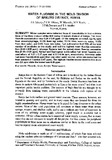| dc.contributor.author | Gikunju, J K | |
| dc.contributor.author | Mbaria, J M | |
| dc.contributor.author | Mureithi, W | |
| dc.contributor.author | Kyule, M N | |
| dc.contributor.author | McDermott, J J | |
| dc.contributor.author | Maitho, T E | |
| dc.date.accessioned | 2013-06-13T13:00:13Z | |
| dc.date.available | 2013-06-13T13:00:13Z | |
| dc.date.issued | 1995 | |
| dc.identifier.citation | J K Gikunju, J M Mbaria, W Mureithi, M N Kyule, J J McDermott and T E Maitho (1995). Water Fluoride in the Molo Division of Nakuru District, Kenya. Fluoride Vol. 28 No.1 17-20 1995 | en |
| dc.identifier.uri | http://erepository.uonbi.ac.ke:8080/xmlui/handle/123456789/33169 | |
| dc.description.abstract | Water samples were collected from 40 households in four sublocations
of the Molo division of the Rift Valley in Nakuru District of Kenya. The mean
fluoride concentration was 0.28 ± 0.03 ppm. Of the samples collected, 62.5% were
from streams/springs, 15.0% from tap water, 10.0% from borehole water, 10.0%
from dam water, and 2.5% from rain water. Turi sublocation had 75% of the total
number of boreholes in this study, and had the highest mean fluoride concentration
(0.44 ± 0.06 ppm), whereas Kamara had the lowest mean fluoride concentration
(0.19 ± 0.08 ppm). Kerisoi and Sachagwan sublocation had mean fluoride concentrations
of 0.21 ± 0.07 ppm and 0.32 ± 0.04 ppm, respectively. Borehole water
had more fluoride (0.66 ppm) than any other water source, while rain water had the
least amount of fluoride (0.07 ppm). The highest fluoride encountered in this study
was 2.0 ppm while the lowest was 0.06 ppm. | en |
| dc.language.iso | en | en |
| dc.title | Water Fluoride in the Molo Division of Nakuru District, Kenya | en |
| dc.type | Article | en |

